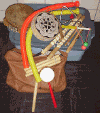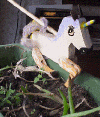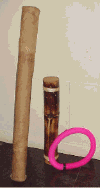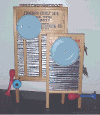|









| |
|
Drums & other percussion instruments:
Bodhran:
Smith's College Museum of Ancient Inventions has a page on the
Bodhran. Bongo
drums: I found a nice page on the bongo drums it includes a bit about playing them. Here is a nice page to percussion sites on the web and here's another. I do like my
conga drums if you do, too, go to the Conga drum page! Or maybe you'd prefer to make your own drum - this link will take you where you can order drum building
supplies.
 I have so many percussion instruments
now.; enough to hand out to a grade school class and have stuff left over which is what I did at Meadowlawn School. I did drumming
with the entire school. I got every class for
10 minutes. Not a long time to explain the
instruments and drum. But it was long enough to allow
the kids to briefly try 3 or 4 instruments. They had a great time! I have so many percussion instruments
now.; enough to hand out to a grade school class and have stuff left over which is what I did at Meadowlawn School. I did drumming
with the entire school. I got every class for
10 minutes. Not a long time to explain the
instruments and drum. But it was long enough to allow
the kids to briefly try 3 or 4 instruments. They had a great time!
Pictured above (click to see full size)
Egyptian
tambourine, whirleys, small
Native American drum,
triangle,
rasps, lummi sticks, whirling
drum, shaker,
yo-ball stick
I bought my
dum dum - African talking drum -
from an African who was in Sandusky at a festival. He was
from a store in Oberlin, Ohio called Ade's Place. The store has
wonderful things African. I bought my Egyptian-made
tambourine from Ade's Place, too.
I am very fond of
Ebay Auction. It is a fun place to
pick up odd used and new instruments. I bought my
conga drums, black African
drum, dumbecks, bongos,
maracas, and..... (the list keeps growing.)
Egg shakers are easy to make from those plastic
Easter eggs. Fill with some dried beans and tape it. I use
black electrical tape. I have a couple of the nice
commercially made ones, too. They are less likely to
break....
The finger cymbals were purchased used from a
local music store, Sandusky Music.
 The
limberjacks were purchased from Elderly Instruments. I have two: Mr. Tap
and Mel Gibson. (I was looking through
magazines to find a picture of Clinton to put on the limberjack but decided on Mel
instead.) Firelands Dulcimer Club owns all
the animal ones available from Elderly. One of the
members painted them. The frog is my favorite. The
limberjacks were purchased from Elderly Instruments. I have two: Mr. Tap
and Mel Gibson. (I was looking through
magazines to find a picture of Clinton to put on the limberjack but decided on Mel
instead.) Firelands Dulcimer Club owns all
the animal ones available from Elderly. One of the
members painted them. The frog is my favorite.
I took a class and made my
Native American hand
drum
and beater. It is a neat instrument. Skin is a deer
skin from a deer killed in Michigan. The hide was tanned (I
didn't do it) in the traditional way. Deer brains were
rubbed into it to preserve it. The beater is stuffed with
cattails (plant). Drum is decorated with deer hooves....
The
rasps were made by my dad. I got the directions
from a book from the library. It is a Native American
instrument. When I put the end on a drum, it does sound a
bit like a growling bear.
My bodhran was purchased from Elderly Instruments. I bought a nice tipper from Lark in the Morning I was describing the instrument as an Irish bodhran when I was stopped by Brad
Keppler. Brad is "the Great Lakes Minstrel" and sings American and Celtic folk music. He is of Scottish descent.
He said "You can't call it an Irish
bodhran; the Scots have them, too!"
I said "You are absolutely correct, Brad. Actually, this is a Pakistani bodhran because it was made in Pakistan!"
Brad is a really good musician and singer. He knows many really neat songs about the Great Lakes. I always enjoy meeting up with him at
festivals.
 Tin can shakers/maracas
are fun to make. I bought cans of chicken bouillon which are easy to empty through a hole in the center of
the lid. Then another hole is put in the center of the bottom. Clean it thoroughly and let it dry. Put
Tin can shakers/maracas
are fun to make. I bought cans of chicken bouillon which are easy to empty through a hole in the center of
the lid. Then another hole is put in the center of the bottom. Clean it thoroughly and let it dry. Put
 a dowel through the holes. The method I used to keep the dowel in place was wrapping the dowel next the the can very tightly with string covered in glue. Then decorate...
a dowel through the holes. The method I used to keep the dowel in place was wrapping the dowel next the the can very tightly with string covered in glue. Then decorate...
I bought my rain stick at the Sandusky Mall. I was just given a homemade one from a teacher at Meadowlawn school. My
circular one? You know that flexible plastic pipe that is all wiggly? Just put some rice in it and bend it into a circle and fasten. Works great!
Picture of my rainsticks on the left.
|
|
Bones:
"One of the oldest instruments known to man or beast, the bones can be played with either one hand (English Style) or with a pair in both hands (American Style). For proper bones plying, you need to have them dance in your hands to the rhythm of the music. Be sure to hold the top bone, the one between your first and middle finger rigid. The clacking is all done by the movement of the bottom bone, the one between your middle and ring finger.
"To get the bones to dance and keep rhythm, quickly rotate your forearm and snap your wrist in time with the music. You can get different sounds by where you hold the bones. Double clacking can be accented by holding the top bone more
rigid."
from Hills Craft Instruments
"As folk instruments, traditionally dried rib bones from cooked beef. Commercial varieties are made of rosewood or hard plastic. The bones have been popular instruments since long before the Victorian association with troupes of "Black"
minstrels."
from
The Oxford Companion to Musical Instruments
I didn't learn from a video. I learned from a local fiddler, Howard
Schlegel, who plays Civil War Fiddler Music from the North or South. I bought two sets of carved wood bones so I can play American style. I ordered several sets of plastic ones from Elderly Instruments so I could show grade school kids how to play them. I recently inherited my great Uncle Strobel's bones......
Click here for Lark in the Morning which has all kinds of bones to order and neat information about them!
|
|
Lummi
sticks:
Wow, isn't the Internet great! I finally found someone who knew something about them and click here for her web page! The following is from her page - by
Carol Greene, Los Gatos, California / Girl Scouts of Santa Clara County
"Currently, much emphasis is being placed in the schools on exploring many different multi-ethnic cultures. Lummi Sticks is a game that originated with the Lummi Indians who are the farthest north of the Puget Sound tribes.
(Lummi is generally pronounced with a short u, but the tribe name has a long u
sound.)"
Click here for a Maori web page with a song to sing with
rhythm sticks!!
|
|
Popgun:
How can you possibly to justice to
"Pop Goes the Weasel" without one? I got mine at a festival at Put-in-Bay. Here is a bit of history from a web page on 19th Century
Amusements:
"The popgun has been around since at least the
1700's. The earliest reference we've found that
illustrates a popgun is from a
boy's activity book printed in 1860. The popguns sold by settlers at
re-enactments are almost identical to that one. Using a simple piston, the
popgun fires a cork attached to a string. If the handle is pulled back far
enough to force the cork stopper back into the tube of the barrel, it reloads
and is ready to "pop" again."
|
|
Spoons,
catspaws, cheater spoons:
There
is a really nice web
page by David Holt on how to play spoons...and if you still can't get
it, you can order his video! Catspaws are carved out of wood and are like
having two wooden spoons stuck together! Easy to play!
|
|
Thumb piano or
Mbira:
Interested in this instrument - click to go to the Mbira website! This is a great site on African music! I bought mine from
Ebay.
|
|
Washboard:
 I have two
washboards. The large one is for regular laundry and the smaller one is for delicates or traveling. Neither one has ever seen water....bought them from Wholf's Hardware here in Sandusky - before it closed. Washboards are still manufactured in
Columbus, Ohio by the Columbus Washboard Company.
Each year a new limited edition washboard!! I have two
washboards. The large one is for regular laundry and the smaller one is for delicates or traveling. Neither one has ever seen water....bought them from Wholf's Hardware here in Sandusky - before it closed. Washboards are still manufactured in
Columbus, Ohio by the Columbus Washboard Company.
Each year a new limited edition washboard!!
Link
to Rhythm Board Ray from West
Virginia
Link to a French washboard web page - in French or translated to English
|
| |
|
![]()